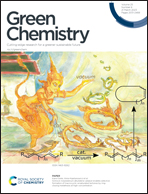Electromagnetic mill promoted mechanochemical palladium-catalyzed solid state cyanation of aryl bromides using non-toxic K4[Fe(CN)6]†
Abstract
Since Takagi et al. first developed palladium-catalyzed cyanation in 1973, transition metal-catalyzed cyanation of aryl halides, using Pd, Ni and Cu, has attracted widespread interest. However, the reactions are all dependent on highly polar organic solvents and high temperatures. Herein, we have developed the first electromagnetic mill (EMM) promoted mechanochemical palladium-catalyzed solid state cyanation of aryl bromides using non-toxic K4[Fe(CN)6] without additional heating. This strategy features broad substrate scope, good functional group tolerance, liquid-assisted grinding, air and moisture insensitivity, no additional heating, and efficient gram-scale synthesis. The EMM conditions can improve the efficiency of the reaction by colliding better mixed solid reactants with ferromagnetic rods at high speed. This EMM system not only provides a simple method for the preparation of aromatic nitriles which have a wide industrial application prospect, but also affords a broad space for liquid-assisted grinding solid metal catalytic synthesis.
![Graphical abstract: Electromagnetic mill promoted mechanochemical palladium-catalyzed solid state cyanation of aryl bromides using non-toxic K4[Fe(CN)6]](/en/Image/Get?imageInfo.ImageType=GA&imageInfo.ImageIdentifier.ManuscriptID=D2GC04506K&imageInfo.ImageIdentifier.Year=2023)


 Please wait while we load your content...
Please wait while we load your content...